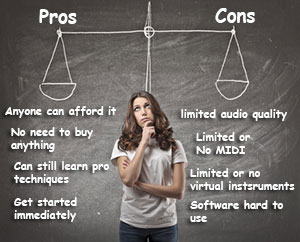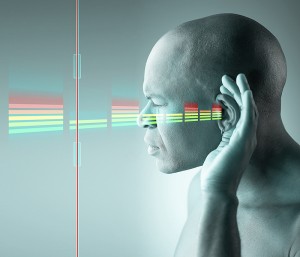 Most people don’t know that they can get started recording audio with a budget as small as $5.00. The only reason I don’t say zero dollars is that if you don’t have a microphone, you’ll need to buy one. A plastic PC mic will even suffice at this point. Now, those folks with experience recording audio from home will likely take issue with what I just said, so for them allow me to clarify. I recommend the cheapest recording set-up for beginners because they can still learn most of the basics they’ll ever need to know with that gear. Also, by learning the limitations of their current set-up, they will be better informed as to what else they need to get to the next level. I do not propose that the lowest budget recording studio will allow the most stunning audio ever. But most folks, even you experts out there, would be surprised at how good the audio produced from a “low-end” studio can be!
Most people don’t know that they can get started recording audio with a budget as small as $5.00. The only reason I don’t say zero dollars is that if you don’t have a microphone, you’ll need to buy one. A plastic PC mic will even suffice at this point. Now, those folks with experience recording audio from home will likely take issue with what I just said, so for them allow me to clarify. I recommend the cheapest recording set-up for beginners because they can still learn most of the basics they’ll ever need to know with that gear. Also, by learning the limitations of their current set-up, they will be better informed as to what else they need to get to the next level. I do not propose that the lowest budget recording studio will allow the most stunning audio ever. But most folks, even you experts out there, would be surprised at how good the audio produced from a “low-end” studio can be!The Pros of a $5.00 PC Recording Studio
So what are the “pros” of a $5.00 home recording studio? Let’s take a look at the top three:
- Cost: According to the US Census Bureau as long ago as 2003, “The majority of households have personal computers and Internet access. In 2003, 70 million American households, or 62 percent, had one or more computers, up from 56 percent in 2001.” More recent estimates put that percentage closer to 70 percent. That means that if they wanted to, 7 out of every 10 people in the US could start a home recording studio in the next hour.
- Capability: In 2013, the availability of open source audio software and the average quality of consumer computers make it possible to do: multi-track” (recording one sound, then recording another on top of the first as you listen, etc.) recording at this budget level. Editing and mixing tools in the software make it possible to pan sounds left and right, equalize and otherwise treat or fix audio problems, and mix down to a stereo master file. That was pretty-much unheard of 10 years ago.
- Affordable Upgrading: If you walked into a music store today and told a salesman you wanted to start a home studio, he’d try to talk you into spending several hundred (or even thousands of) dollars. You’d have some pretty nice gear, but odds are that you won’t need a majority of that gear to do what you need to do. You’ll also be totally overwhelmed by the knowledge needed to operate all this gear. The $5.00 studio is easy to learn, and allows you to incrementally add gear and/or software in order to achieve exactly the quality you need. That will save you time, frustration, and money in the long run.
The Cons of a $5.00 PC Recording Studio
- Noise: At the lowest budget, sound is recorded through a very small microphone going directly into a factory sound card on an “average” computer. You’ll have noticed that there is a lot of buzzing, humming and hissing noise when you record with this equipment. There are things you can do to minimize noise, such as keeping the mic wire as far from plugs or other power sources as possible. You can also treat the noise after it’s recorded. But at the end of the day, the physical limitations in the amplifiers in “regular” sound cards, and construction of the $5.00 PC mics will mean a fair amount of noise is inevitable.
- Capability: There are things you simply cannot do at the lowest budget level, such as use make use of MIDI, virtual instruments, record more than one track at a time, etc.
- Ease of use: The $5.00 budget studio doesn’t have room in the budget for things like microphone stands, patch bays, cables, etc. It can be pretty slow-going trying to set the PC mic up to capture piano or guitar without a little more effort than many folks find feasible. Also, the cables for these mics tend to be pretty short, again making it difficult logistically to record.
Those are the major pros and cons of starting your home studio with the “zero-to-five-dollar” budget. The great thing about that budget level, though, is that you have little-to-nothing to lose and everything to gain. Once you get comfortable with the limitations, you can address them one-by-one, incrementally improving your set-up according to your own needs. Chances are good that if all you need to do is record your voice for podcasts, or video narration, you can get the quality you need by spending as little as $25 extra dollars for a USB microphone. Whatever your ultimate needs are, you really can’t go wrong starting at the lowest budget and working your way up.
Learn to record and produce professional-sounding audio from home without spending a dime for gear. Fun and short video tutorials show you how. We’ll show you how to start with a $0-$5 budget, and then how to improve your studio for a few dollars at a time as your knowledge and confidence increase.
See you around campus!

 These interface units are actually doing two main jobs – conversion, as I just discusses a bit (no pun intended :-)), and amplification (mic preamps). In the old days you’d have two units for this – a converter and a preamplifier. But mostly these days (updating this in 2018) these interface units combine many functions, including A-D conversion, D-A conversion, and preamplifiers.
These interface units are actually doing two main jobs – conversion, as I just discusses a bit (no pun intended :-)), and amplification (mic preamps). In the old days you’d have two units for this – a converter and a preamplifier. But mostly these days (updating this in 2018) these interface units combine many functions, including A-D conversion, D-A conversion, and preamplifiers.
 If you’re wondering what the heck a
If you’re wondering what the heck a